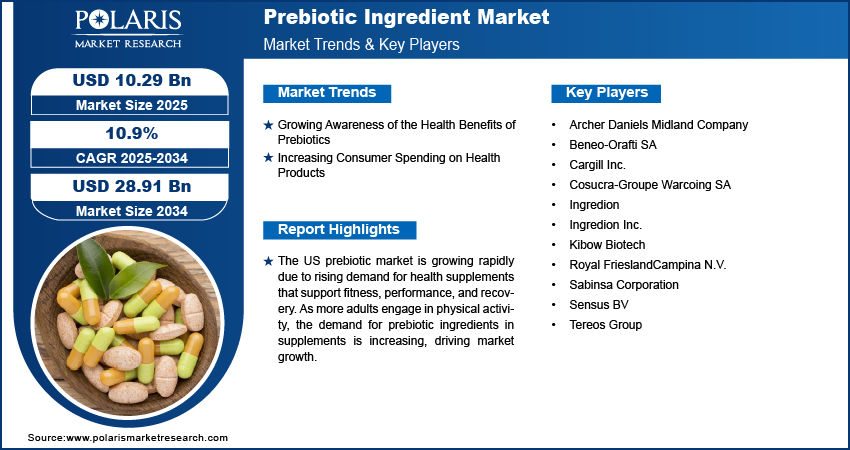Prebiotic Ingredient Market Expected to Reach USD 28.91 Billion by 2034, Growing at a CAGR of 10.9%

The prebiotic ingredient market was valued at USD 9.22 billion in 2024 and is expected to grow from USD 10.29 billion in 2025 to USD 28.91 billion by 2034, registering a CAGR of 10.9% during the forecast period.
Key Market Trends & Insights
- Rising Demand for Gut Health Products: Growing awareness of digestive wellness is fueling demand for prebiotic-enriched foods, supplements, and beverages.
- Functional Food & Beverage Innovation: Prebiotics are being incorporated into a wide range of functional foods and drinks, aligning with health-conscious consumer preferences.
- Clean Label & Natural Ingredient Movement: Consumers increasingly prefer natural, non-GMO, and plant-based prebiotic sources, boosting innovation in organic formulations.
- Synergy with Probiotics (Synbiotics): The growing popularity of synbiotic products (prebiotics + probiotics) is creating new growth avenues across the nutrition and wellness sectors.
Market Size & Forecast
Market Size Value in 2025: USD 10.29 billion
Revenue Forecast by 2034: USD 28.91 billion
CAGR: 10.9% from 2024 to 2032
Market Overview
The prebiotic ingredient market is gaining traction as consumers place greater emphasis on gut health, immunity, and overall wellness. Prebiotics—non-digestible fibers that stimulate the growth of beneficial gut bacteria—are increasingly being used in food, beverages, dietary supplements, and even animal feed. Their ability to improve digestion, enhance nutrient absorption, and support immune function makes them an essential component of modern health-oriented diets.
With the rise of functional foods, clean-label products, and plant-based nutrition, the demand for natural prebiotic sources like inulin, fructooligosaccharides (FOS), and galactooligosaccharides (GOS) is on the rise. Manufacturers are actively developing new applications and delivery formats, such as bars, drinks, gummies, and capsules. As health awareness continues to grow globally, the prebiotic ingredient market is positioned for steady and sustained expansion across both developed and emerging economies.
Key Market Growth Drivers:
- Increasing Focus on Digestive Health and Immunity: Consumers are proactively seeking ingredients that improve gut microbiome and overall wellness.
- Rising Popularity of Functional and Fortified Foods: The integration of prebiotics into everyday food and beverage products is driving widespread adoption.
- Growing Prevalence of Lifestyle Disorders: Conditions like obesity, diabetes, and IBS are pushing demand for gut-supportive dietary solutions.
- Surge in Vegan and Plant-Based Nutrition: Natural plant-derived prebiotics align with growing demand for clean-label and vegan-friendly formulations.
- Expanding Applications in Animal Feed: The livestock industry is adopting prebiotics to boost animal health and productivity, reducing reliance on antibiotics.
Request for Free Sample:
https://www.polarismarketresearch.com/industry-analysis/gene-therapy-market/request-for-sample
Market Challenges:
- High Production and Processing Costs: Manufacturing prebiotic ingredients involves complex extraction and purification processes, increasing costs.
- Regulatory Complexity: Differences in labeling and health claim approvals across regions may hinder global product launches.
- Limited Consumer Awareness in Developing Markets: In many regions, prebiotic benefits are not yet well understood, limiting market penetration.
- Taste and Texture Concerns in Formulations: Incorporating prebiotics into foods without compromising taste or texture remains a formulation challenge.
- Competition from Probiotics and Other Supplements: While synergistic, prebiotics sometimes take a backseat to more widely recognized probiotics in consumer perception.






